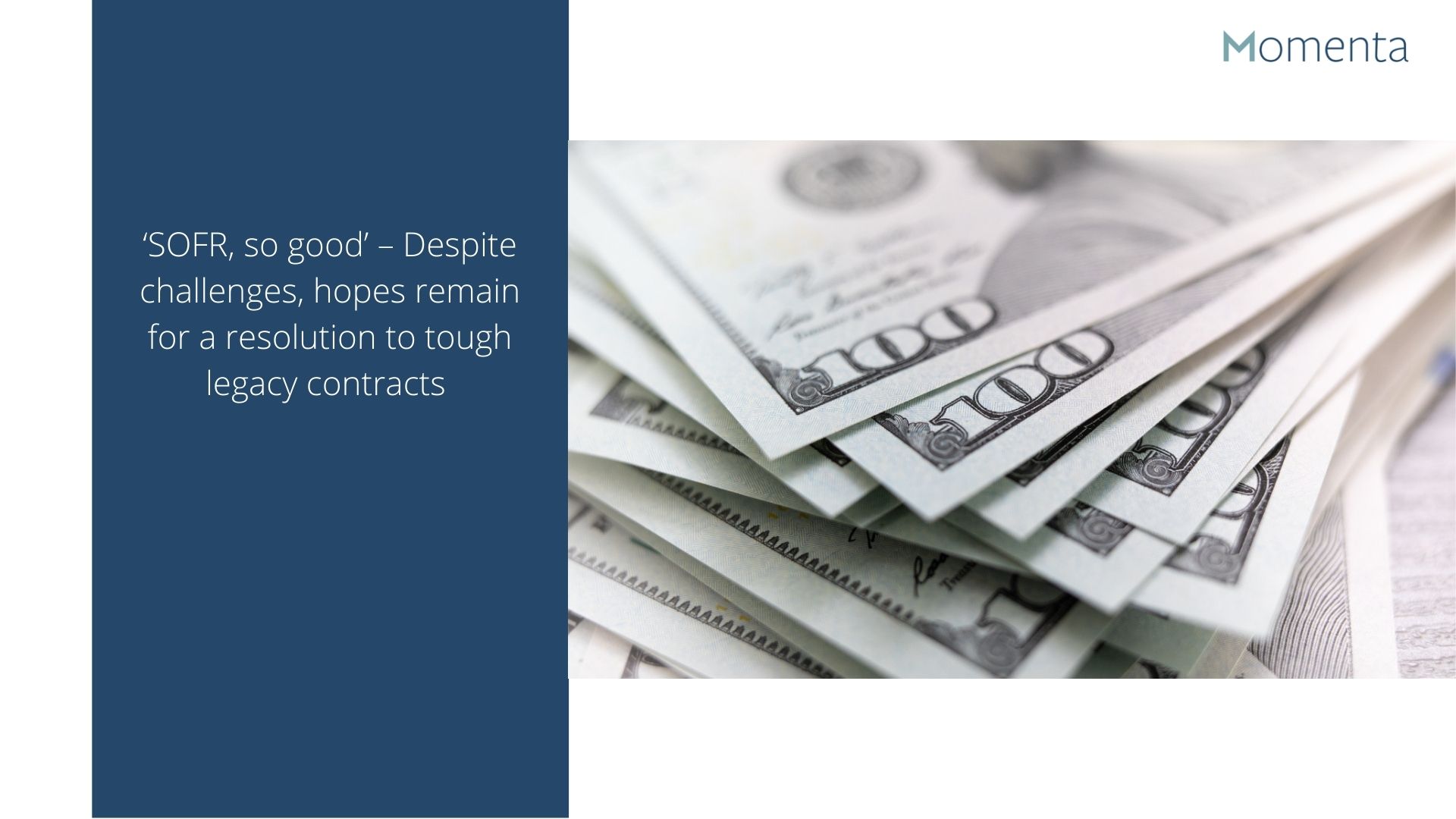‘SOFR, so good’ – Despite challenges, hopes remain for a resolution to tough legacy contracts
The LIBOR Legislation Bill has recently been passed by New York State, raising hopes of a smoother transition for tough legacy contracts in the US. In this latest Momenta insight, we will dig deeper into the detail of the bill and what it means for US firms as they navigate the LIBOR transition process during 2021.
As a result of this bill being passed into law, contracts without LIBOR fallback provisions will now be given a legal basis to be switched from LIBOR to SOFR, once the cessation of LIBOR is completed.
The bill will prove crucial to solving a key challenge – minimising litigation risk. Prior to the bill being passed, both counterparties would have to agree on a benchmark rate, which is not as simple as it sounds. If one party does not agree on the change it could result in litigation, and with a looming deadline, it will be a herculean task to resolve – and one that will require additional time, money, and resource.
Why is this such an issue for tough legacy contracts?
The nature of differing benchmarks replacing LIBOR brings with it an array of complexities. Replacing LIBOR with SOFR is no easy task as LIBOR is a forward-looking rate and SOFR is a backward-looking one.
LIBOR contains a built-in credit component, meaning the LIBOR rates quoted by panel banks consider the respective banks’ term rate liquidity risk and credit risk. SOFR, however, being a “risk-free rate”, contains minimal credit risk.
Plus, LIBOR is an interbank unsecured lending rate, measuring the average rate banks with access to the wholesale, unsecured funding market could obtain funds. By comparison, SOFR is based on overnight transactions secured by US Treasury securities. It, therefore, represents the funding cost of secured transactions[1].
Many market participants and industry bodies have indicated their concerns to regulators that there will be several legacy LIBOR referencing contracts without appropriate fallbacks that will continue post 2021 and 2023 (for US based contracts). These contracts are unable to either convert to a non-LIBOR rate or be amended to add fallback, as most tough legacy contracts do not have ones accommodating the change.
According to Bobs Guide , an estimated $74 trillion worth of LIBOR indexed transactions will be outstanding as of the June 2023 deadline. This will be an issue for the derivatives and bonds markets as many will not have the appropriate fall-backs to accommodate a SOFR transition.
How will this new legislation help?
The new legislation intends to amend New York’s General Obligations Law to provide that, once a “LIBOR Discontinuance Event” has occurred, and either lack any post-cessation fallback provision, a fallback is included that itself relies on LIBOR or on polling banks for interbank lending rates [2].
JDSPORA has listed the following 4 key legislative changes that business must be aware of:
- SOFR will be presumably accepted as a suitable replacement for U.S. Dollar LIBOR
- A party to a legacy contract governed by New York may not refuse to perform its contractual obligations, declare a breach of contract, or recover damages as a result of the discontinuance of U.S. Dollar LIBOR;
- The use of SOFR in place of U.S. Dollar LIBOR may not be considered to have a material or adverse effect on any person’s rights under the contract;
- Where a person with contractual discretion to select a replacement rate (a “Determining Person” as defined in the statute) has chosen SOFR as the replacement rate, that decision is protected from litigation by a statutory safe harbor.
What about the implications of the Trust Indenture Act?
To add more complexity to the issue at hand, there is the Trust Indenture Act of 1939 (the “TIA”), which creates questions about the enforceability of the recent New York State LIBOR Legislation.
The NY LIBOR Legislation stipulates that, in the case of many New York law-governed contracts that reference LIBOR and that do not have adequate fallback provisions to determine what happens when LIBOR ceases , a new “benchmark rate” recommended by the appropriate authorities (e.g. SOFR) will, by operation of law, be used for such contracts in lieu of LIBOR [3].
This is a significant step towards LIBOR cessation. Many legacy contracts including U.S. Dollar LIBOR may, however, be governed by the laws of other states. Proponents of the New York legislation hope that it prompts other state legislatures, and most significantly the U.S. Congress, to enact similar legislation.
How can Momenta help your business navigate this minefield of regulatory change?
Momenta are a global contingent resource solutions firm that has, for over 30 years, been partnering with companies in the financial services, legal, technology, and training and development sectors to cost-effectively provide the right people, with the right skills, at exactly the right time.
We can, and already do for many of our clients, provide the right resource in key areas, allowing you to focus on the strategic oversight of the project at-hand, whilst we help to implement your vision.
This flexibility allows you to ensure that there is always the right balance amongst your team, delivering an effective solution that will produce the desired end results.
If you require assistance in the form of additional resource (no matter how far you are progressed with regards to your LIBOR transition plans), contact us today to see how we can help to ensure your firm is prepared for LIBOR’S cessation in December 2023.
Alternatively, if you are looking to progress your career and have LIBOR experience, contact our dedicated resourcing team for an opportunity to be placed in one of the leading global firms involved in this transition process. You can also find out more about the different LIBOR roles we provide to our clients here.

